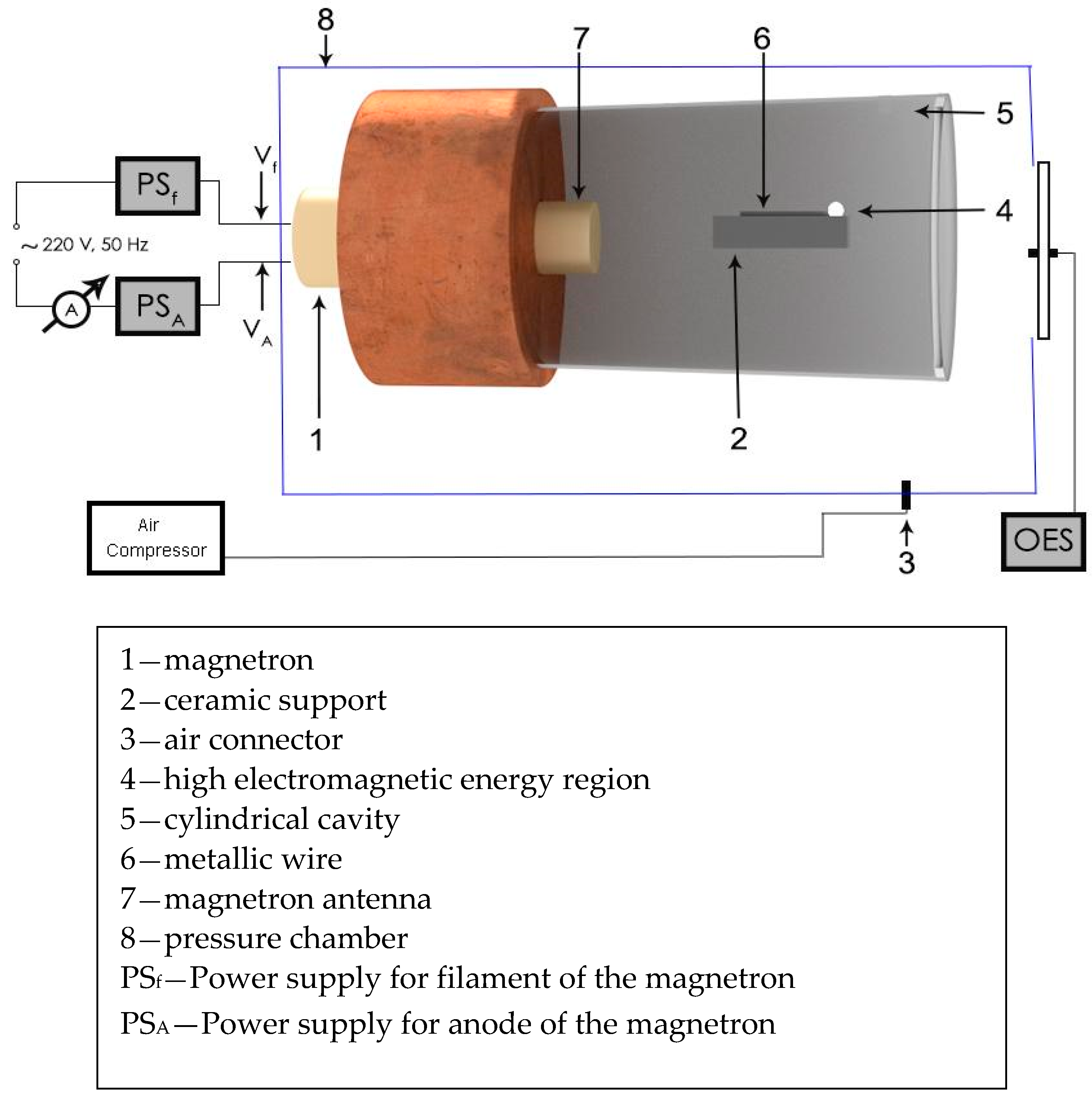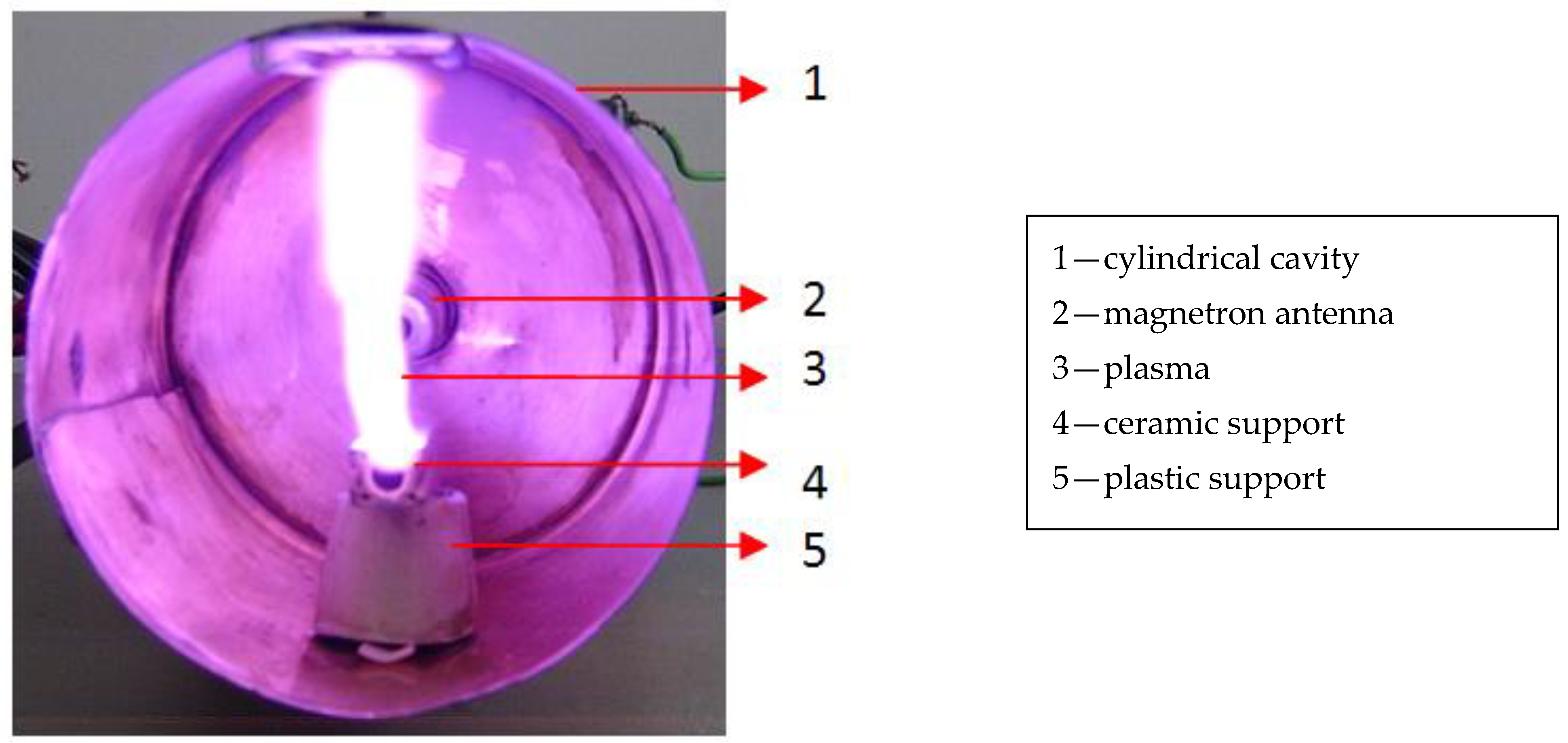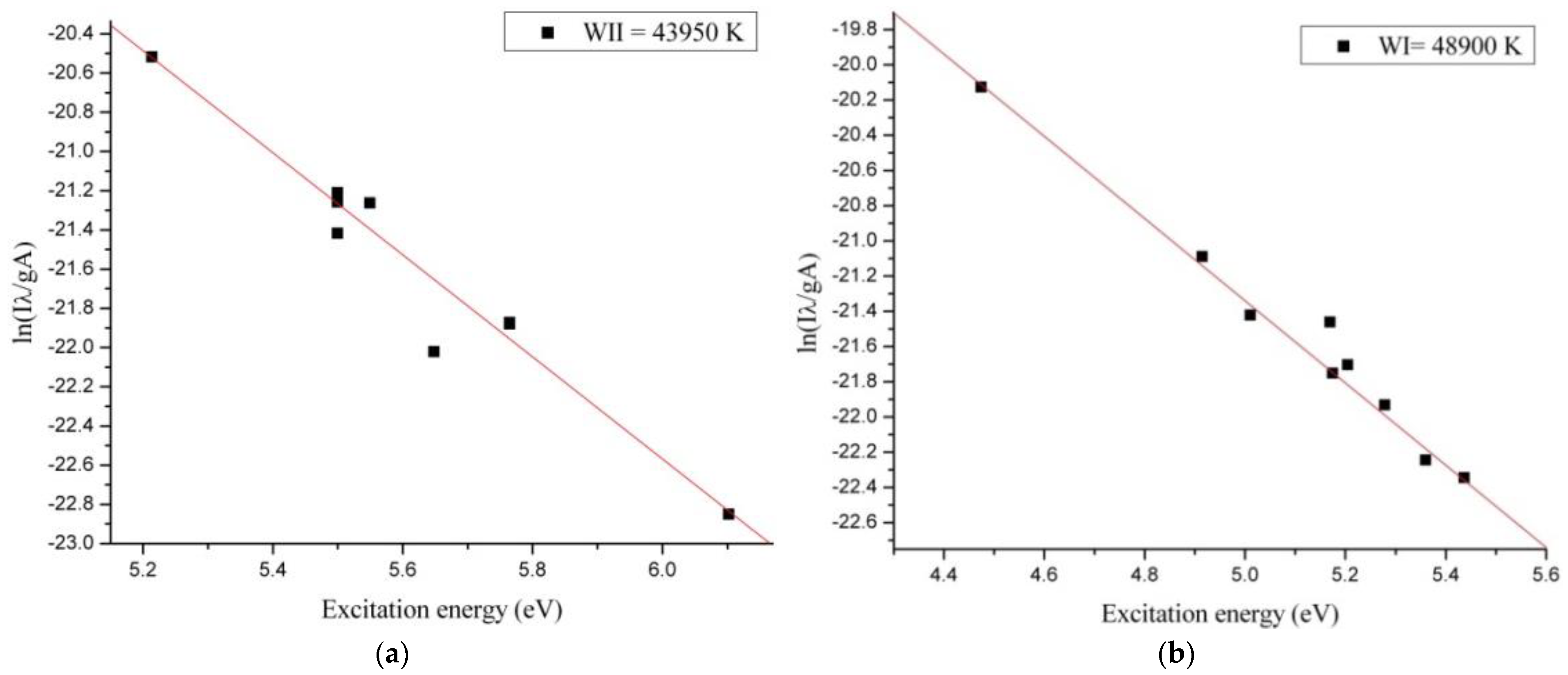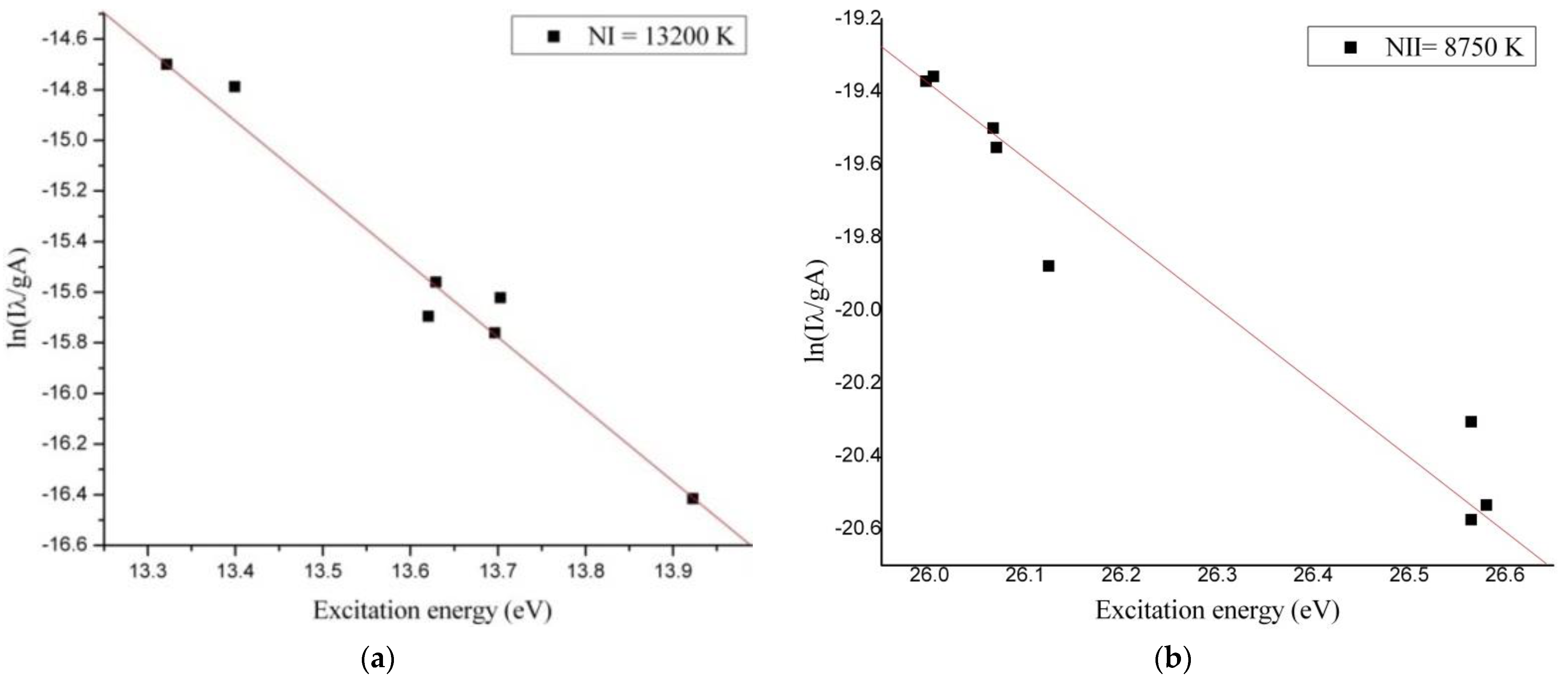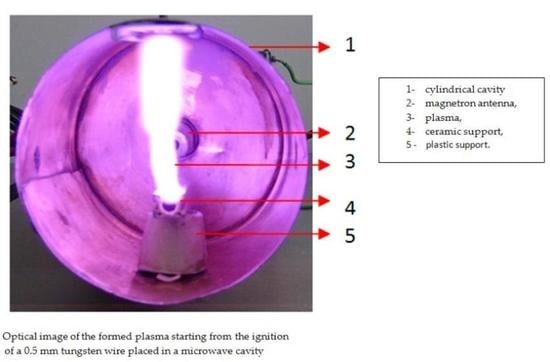1. Introduction
The propagation of electromagnetic radiation in different media has been a topic of great interest both for science and industry. It is known that the absorption and reflection processes of the microwaves strongly depend on the material properties. Gases and liquids can absorb the microwaves [
1,
2,
3], while bulk metals reflect them [
4].
In 2000, Whittaker et al. [
5] showed that metal powders mixed in a liquid media and exposed to 600 W microwave these can generate electrical arcing, having as result the heating of the liquid through ohmic effect.
In 2001, Chen et al. [
6] showed that metals in powder form can become microwave absorbent. Using the TE
103 single-mode cavity coupled to a microwave source, metal powders were heated under a nitrogen atmosphere.
To evaluate microwave absorption efficiency of the metallic powders, Mondal et al. [
4] exposed copper powders with different particles size to a microwave field. In their experiment, the powders reached a temperature of 1200 °C for
particles size, while metal powders with
particles size reached only 800 °C.
The temperature values of the metallic powders obtained in interaction with microwaves were attributed to the skin depth (
) value of the particles. In their work the authors highlighted that metallic particles with
particle size are better microwave absorbent. Other similar experiments were performed by Popescu S. et al. [
7]. Using two metallic pieces (a titanium electrode and a titanium plate) brought into contact when irradiated in a microwave field, the authors managed to generate a plasma in atmospheric air. Therefore, not only metal powders can become microwave absorbent, but under certain conditions, metal wires can also absorb microwaves.
Since 2010 we have conducted several studies on microwaves interaction with electrically isolated metallic wires. The experimental studies showed that metal wires much thicker than the material skin depth value can absorb the microwaves [
8,
9,
10] having as an effect the generation of a plasma. In our experiments we also observed that not all metallic wires can be ignited by the microwave field.
Taking into account the current scientific literature, the aim of this work is to investigate the microwave ignition process of the metallic wires as a function of their diameters and the plasma characterization generated in this process.
Therefore, using a commercially available magnetron coupled with a cylindrical cavity we irradiated two types of wires with microwaves: tungsten wire of 5 cm length with 0.5 mm diameter and tungsten wire of 5 cm length with 1.0 mm diameter.
The experiment was realized in air at normal pressure. The experimental results showed that the tungsten wire with 0.5 mm diameter was vaporized in interaction with the microwave field, while the tungsten wire with 1 mm diameter was not ignited by microwaves. To determine the voltage induced by microwaves in these tungsten wires we calculated the electric voltage as a function of their electric resistance in AC (alternating current) and the power of the microwaves.
The theoretical results showed that the metallic wire with 0.5 mm diameter exposed at 800 W microwave power emitted by magnetron can easily reach the breakdown voltage value in air. Moreover, in microwave discharge process, the tungsten wire with 0.5 mm diameter generated a self-sustaining plasma. Using optical emission spectroscopy method (OES) we found that the metallic wire and gas (air) around of the metallic wire was ionized.
2. Materials and Methods
To study the behavior of metallic wires in interaction with the microwaves we exposed them to a high-power microwave field. Using a commercially available magnetron (frequency (
f) = 2.45 GHz, microwave power = 800 W, (Whicepart Electronic LTD, model 2M2013-01TAG, Zhejiang, China)) coupled with a waveguide cavity we obtained a high power of microwaves in the node zone inside of the waveguide. The metallic wires were placed in this zone and then irradiated with microwaves. The single-mode waveguide was constructed in accordance with TM
011 propagation mode (transverse magnetic mode) [
11], its dimensions being 10.5 cm diameter and 11 cm length; the microwaves entering this waveguide were focused in a single point corresponding to the node of the electromagnetic field (
Figure 1).
The focal point of the wave guide is located in the center of the wave guide at 6 cm (half-wavelength) from the magnetron antenna [
12]. The electric field amplitude in this focal point has a very high magnitude, while the dimension of the focal volume is estimated to be around
.
The power flux of the electromagnetic field generated by an antenna is defined by the Poynting vector [
13,
14]:
According to
Figure 1 [
15] the 800 W microwave power emitted by the magnetron antenna will be focused in the focal point of the waveguide, thus obtaining around
in this zone. Since the wave impedance of vacuum or dry air is
, the electric field (
E) in this zone can reach a value of:
If a noncontact metallic wire is introduced in the focal point of the single-mode wave guide (
Figure 2), the microwave field will induce a strong electric field. If the wire is in air or other gas atmosphere the high electric field can rip an electron of an air molecule creating an ionized molecule and a high energy electron, which could through collisions to ionize other molecules. Ionized atoms strongly absorb microwaves, so once a spark appears, the absorption of the microwave power by the ionized medium will rapidly grow causing the generation of a plasma. In the ionization process of gases from electric discharge or microwave discharge, free electrons are generated. According to the Townsend discharge process, the electrons face collisions with gas molecules and the metallic wire causing vaporization of the wire, excitation, dissociation, electron attachment, or ionization of the gas molecules and the metallic vapors [
16].
Given that the distance between successive nodes of the TM cylindrical cavity is 6 cm for
f = 2.45 GHz, the length of the tungsten wires exposed to microwaves was chosen so that they were smaller than the distance between the magnetron antenna and the first node of the waveguide. Tungsten wires were chosen because they have a good electrical conductivity and are slowly vaporized. Also, being a hard material with a very high melting temperature, the wires will not move away from the focal point during vaporization process. To start the experiment, we placed the metallic wire along the cavity symmetry axis with one end in the focal point of the wave guide as schematically shown in
Figure 2. The microwave source was turned on. Under these conditions, the tungsten wires were each exposed for 10 s at 800 W microwave power generated by the magnetron. Following the interaction between the microwave and the tungsten electrode, we analyzed the plasma composition through the OES method [
18,
19] using an Ocean Optics USB 2000 spectrometer (Ocean Optics Inc., Orlando, FL, USA). The optical emission spectrum of the plasma was recorded at 1 ms integration time. The optical resolution gives by the datasheet of the Ocean Optics USB 2000+ spectrometer is: FWHM~0.1 nm [
20]. The spectrometer was calibrated using a broadband light source (Ocean Optics DH-mini UV-Vis-NIR Deuterium-Halogen Light Source) before starting the plasma characterization.
To identify each chemical element (W, N and O) from plasma and correct the emission spectrum of the plasma, we compared our experimental results to three of the most intense spectral lines for each element [
21] from the National Institute of Standards and Technology (NIST) data base [
22].
3. Results
Our experiments showed that the metallic wires can ignite following microwave absorption processes. Not all metallic wires can absorb the microwaves and create a plasma during interaction process.
This conclusion was reached after we exposed to microwaves tungsten wires with different diameters. During the experiment we observed that tungsten wires of only 0.5 mm diameter or less generated plasma, while the 1 mm diameter tungsten wires reflected the microwaves. For the initiation of the plasma in air at atmospheric pressure there must be a high voltage induced in the wire. It is impossible to measure the voltage and current generated in the tungsten wire because the presence of a probe inside the microwave field can influence the result of the measurement. To evaluate the voltage induced by microwaves in metallic wires, we calculated the electric resistance (RAC) in AC of the tungsten wires using the following parameters: the frequency of the electromagnetic radiation, physical properties of the material (magnetic permeability and electrical conductivity) and the length and diameter of the metallic wire.
Knowing that the impendence (
Z) of the metallic wire is [
23]:
we determined that
If the current density is significant throughout the wire, including along the axis of the wire, δs can be approximated by .
In this case
RAC is:
for tungsten µ ~ 1, σ = 2 × 10
7 S/m,
f = 2.45 GHz [
24,
25].
Where Z is the impedance of the metallic wire, µ is the magnetic permeability, σ is the electric conductivity, f is the frequency of the electromagnetic radiation, l is the length of the metallic wire, and a is the radius of the metallic wire.
The
RAC for the two metallic wires are: 624 Ω for 0.5 mm tungsten wire and 312 Ω for 1.0 mm tungsten wire. Because the metallic wire can be associated with a resistor we can determination the voltage generated by the wire using the Ohm law:
where
P is the microwave power in the node region (8 MW),
R is the
RAC, and
V is the electric voltage.
The voltage induced by microwaves in the two tungsten wires:
In
Figure 3, an image of generated plasma due to the interaction of the tungsten wire of 0.5 mm diameter with the microwave field is presented.
To identify the excited neutral atoms species (nitrogen (NI), oxygen (OI), tungsten (WI)) and the ions species (nitrogen (NII), oxygen (OII), tungsten (WII)) [
26] from plasma we used the OES method. In
Figure 4 the emission spectrum of the plasma at atmospheric pressure recorded from the 0.5 mm W wire plasma is displayed.
Span V.1.7 spectrum Analyzer software [
27] was used to identify the optical emission spectra of the plasma. From optical emission spectrum (
Figure 4) we observed that in microwave discharge the WI, WII, NI, NII, OI and OII species were generated. To evaluate the plasma parameters, we determined the electronic excitation temperature. The electronic excitation temperature of tungsten, nitrogen, and oxygen atoms and ions from the plasma were determined using the Boltzmann plot method, which assumes that local thermodynamic equilibrium (LTE) is met within the plasma [
28].
To build the Boltzmann plots we compared our experimental results with NIST database and we selected only non-overlapping spectral lines. The energetic domain presented on X axis from the Boltzmann Plots corresponded with the frequency of the spectral lines selected for determining the electronic excitation temperature of the excited neutral atoms and ions species.
4. Discussion
The interaction of nonionizing electromagnetic radiation with matter is a subject of interest both for science and technology. It is known that bulk metal reflects microwaves while metal powders are heated through the microwave absorption process. However, our experimental results are based on the ignition of metallic wires and generation of the plasma following the microwave absorption process.
The theoretical results explained the experimental ones that only the metallic wire with a diameter of 0.5 mm can “capture” enough energy from the microwave field to create a breakdown in the atmospheric air. An exact value of the breakdown voltage of the atmospheric air is difficult to estimate because its value depends on many parameters (AC or DC voltage, value if the electric voltage, humidity, pressure, temperature) [
29], but our simple estimate was quite close to the predicted value.
If the microwave power is smaller than 800 W or the wire length is smaller than 5 cm, the metallic wire is very hard to ignite. Once the metallic wire was ignited in microwave discharge process, a self-sustaining plasma was generated. Given that in a microwave discharge process a lot of heat is generated, using a simple physical model we can deduce the conditions of the self-sustaining plasma. The heat generated in microwave discharge leads to an increase of the
RAC of the metallic wire, having as an effect the increase of the electrical voltage in the focal point of the single mode waveguide [
30,
31] and then the generation of the self-sustaining plasma.
Knowing that the plasmas are created between an anode and a cathode, in our experiment the noncontact tungsten wire can be considered to be the anode and the walls of the cylindrical cavity the cathode. The plasma was created in air between one end of the tungsten wire from the focal point of the wave guide and the wall of the wave guide, as can be seen in
Figure 3. The distance between noncontact metallic wire and wave guide cavity was 5.25 cm.
If we refer to this distance, the theoretical value of the electric voltage generated by the 0.5 mm metal wire is around ~14 kV/cm. Given that the breaking voltage in air is 20–30 kV/cm for DC voltage [
32] according to the Paschen’s law [
33] and for AC the breaking voltage decreases with an increase of the frequency [
34], our theoretical results are quite close to previous experimental estimations.
The optical emission spectrum (
Figure 4) obtained in interaction of the microwaves with metallic wire is similar to the profile of the optical emission spectra obtained in high voltage electric discharges [
35]. From the Boltzmann Plot results we noticed that in microwave discharge we obtained a thermal plasma for the excited neutral atoms and ions species. The electronic excitation temperatures of tungsten, nitrogen and oxygen species are shown in
Table 1.
Since the electronic excitation temperature of an element from plasma depends on the excitation energy of the element, in our microwave discharge the electronic excitation temperatures of the WI and WII species were much higher than electronic excitation temperature of the OI, OII and NI, NII species (
Figure 5,
Figure 6 and
Figure 7). If we compare the electronic excitation temperatures of the excited neutral atoms with electronic excitation temperatures of the ions, we observe that the electronic excitation temperature of the excited neutral atoms is greater than electronic excitation temperature of the ions.
Knowing that the electronic excitation temperature value depends by relation
[
36] and the ionization energy is always greater than excitation energy, the electronic excitation temperatures of the ion species are smaller.
The ignition of the tungsten wire with 0.5 mm diameter at 800 W microwave power is a repeatable phenomenon and the emission spectrum does not change over time.
In a simple visual analysis between the distribution of the electric field from TM
011 waveguide (
Figure 1) and generation of the plasma at atmospheric pressure (see
Figure 3), we observed that the plasma did not have the same shape as the distribution of the electric field. The metallic wire does not disturb the mode of the propagation of the electric field from waveguide. However, experimental results performed in vacuum condition showed that the plasma shape was very close to the shape of the distribution of the electric field from TM
011 waveguide [
9]. Therefore, at atmospheric pressure the circulation of air heated from waveguide during microwave discharge process changes the shape of the plasma.
In brief, the results of this work showed that the noncontact metallic wires can become microwave absorbent, and the ignition voltage of metal wires depends on the power of the microwaves and the value of the metallic wire.
5. Conclusions
Using a commercial magnetron coupled with a single mode wave guide, we were able to generate a high temperature plasma from a W wire placed in the focal point of the waveguide. The microwave power, dimension and physical properties of the metallic wire play a crucial role in the ignition process of the plasma by the electromagnetic field. A metallic wire with 5 cm length can ignite a plasma at 800 W microwave power generated by the magnetron only if the value of the of the wire is .
Once the plasma was ignited, very high temperatures were recorded for excited tungsten atoms and ions in air. The plasma is self-sustained because the heat generation in microwave discharge process leads to an increase of the of the metallic wire having as effect the increase of the electrical voltage from focal point of the single mode wave.
Author Contributions
Conceptualization, M.M. and G.M.; methodology, M.M.; software, G.M.; validation, V.C., M.M. and S.I.Z.; formal analysis, V.C.; investigation, G.M.; resources, S.I.Z.; data curation, V.C.; writing—original draft preparation, M.M.; writing—review and editing, G.M.; visualization, M.M.; supervision, V.C.; project administration, G.M.; funding acquisition, S.I.Z. All authors have read and agreed to the published version of the manuscript.
Funding
This work was supported by a grant of the Ministry of National Education and Scientific Research by project code PN-III-P2-2.1-PED-2019-2949 and Nucleu program-contract LAPLAS VI, no. 16N/2019.
Data Availability Statement
The data presented in this study are openly available.
Conflicts of Interest
The authors declare no conflict of interest.
References
- Herlin, M.A.; Brown, S.C. Breakdown of a Gas at Microwave Frequencies. Phys. Rev. 1948, 74, 291–296. [Google Scholar] [CrossRef]
- Zhao, P.; Liao, C.; Lin, W.; Feng, J. Effects of microwave frequency on electron energy distribution function and air breakdown using the fluid model. Prog. Electromagn. Res. M 2012, 26, 279–287. [Google Scholar] [CrossRef][Green Version]
- Ye, D.; Li, J.; Tang, J. Jet propulsion by microwave air plasma in the atmosphere. AIP Adv. 2020, 10, 055002. [Google Scholar] [CrossRef]
- Mondal, A.; Agrawal, D.; Upadhyaya, A. Microwave heating of pure copper powder with varying particle size and porosity. J. Microw. Power Electromagn. Energy 2008, 43, 5–10. [Google Scholar] [CrossRef]
- Whittaker, A.G.; Mingos, D.M.P. Arcing and other microwave characteristics of metal powders in liquid systems. J. Chem. Soc. Dalton Trans. 2000, 1521–1526. [Google Scholar] [CrossRef]
- Cheng, J.; Roy, R.; Agrawal, D. Experimental proof of major role of magnetic field losses in microwave heating of metal and metallic composites. J. Mater. Sci. Lett. 2001, 20, 1561–1563. [Google Scholar] [CrossRef]
- Popescu, S.; Jerby, E.; Meir, Y.; Barkay, Z.; Ashkenazi, D.; Mitchell, J.B.A.; Le Garrec, J.-L.; Narayanan, T. Plasma column and nano-powder generation from solid titanium by localized microwaves in air. J. Appl. Phys. 2015, 118, 023302. [Google Scholar] [CrossRef]
- Mogildea, G.; Mogildea, M. Experimental investigation of the metals vaporization and ionization with microwave used as propellant for ionic propulsion. J. Optoelectron. Adv. Mater. Rapid Commun. 2010, 4, 352. [Google Scholar]
- Mogildea, M.; Mogildea, G. Experimental research for the mass flow control of the metal vaporized and ionized with microwave used in electric propulsion. J. Optoelectron. Adv. Mater. 2010, 12, 1157. [Google Scholar]
- Mogildea, G.; Mogildea, M. Experimental investigation of the microwave electrothermal thruster using metals as propellant. Optoelectron. Adv. Mater. Rapid Commun. 2010, 4, 1826. [Google Scholar]
- Nordling, N.; Micci, M. Low-Power Microwave Arcjet Performance Testing. IEPC 1997, 97, 089. Available online: http://electricrocket.org/IEPC/7089.pdf (accessed on 22 February 2021).
- White, J.F. High Frequency Techniques: An Introduction to RF and Microwave Engineering; Wiley-IEEE Press: Piscataway, NJ, USA, 2013; ISBN 10:0471455911. [Google Scholar]
- Orfanidis, S.J. Electromagnetic Waves and Antennas; Rutgers University: New Brunswick, NJ, USA, 2016; Available online: http://index-of.es/Varios-2/Electromagnetic%20Waves%20and%20Antennas.pdf (accessed on 22 February 2021).
- Jackson, J.D. How an antenna launches its input power into radiation: The pattern of the Poynting vector at and near an antenna. Am. J. Phys. 2006, 74, 280–288. [Google Scholar] [CrossRef]
- Jensen, E. Proceeding: Advanced Accelerator Physics; CERN: Geneva, Switzerland, 2014; Available online: https://cds.cern.ch/record/1982429/files/405-429%20Jensen.pdf (accessed on 22 February 2021).
- Malik, M.A. Nitric Oxide Production by High Voltage Electrical Discharges for Medical Uses: A Review. Plasma Chem. Plasma Process. 2016, 36, 737–766. [Google Scholar] [CrossRef]
- Mogildea, G.; Mogildea, M.; Popa, C.; Chiritoi, G. The Assessment of Carbon Dioxide Dissociation Using a Single-Mode Microwave Plasma Generator. Molecules 2020, 25, 1558. [Google Scholar] [CrossRef] [PubMed]
- Teodorescu, M.; Bazavan, M.; Ionita, E.R.; Dinescu, G. Characteristics of a long and stable filamentary argon plasma jet generated in ambient atmosphere. Plasma Sources Sci. Technol. 2015, 24, 025033. [Google Scholar] [CrossRef]
- Bazavan, M.; Teodorescu, M.; Dinescu, G. Confirmation of OH as good thermometric species for gas temperature determination in an atmospheric pressure argon plasma jet. Plasma Sources Sci. Technol. 2017, 26, 075001. [Google Scholar] [CrossRef]
- USB2000+ Data Sheet. Available online: https://ph208.edu.physics.uoc.gr/pdfs/OEM-Data-Sheet-USB2000-.pdf (accessed on 22 February 2021).
- Devia, D.M.; Rodriguez-Restrepo, L.V.; Restrepo-Parra, E. Methods Employed in Optical Emission Spectroscopy Analysis: A Review. Ing. Cienc. 2015, 11, 239–267. [Google Scholar] [CrossRef]
- National Institute of Standards and Technology (NIST). Atomic Spectra Database. Available online: https://physics.nist.gov/PhysRefData/ASD/lines_form.html (accessed on 22 February 2021).
- Ellingson, S.W. Electromagnetics; Virginia Tech Publishing: Blacksburg, VA, USA, 2020; Volume 2, ISBN 9781949373929. [Google Scholar]
- Periodic Table, Technical Data for Tungsten. Available online: https://periodictable.com/Elements/074/data.html (accessed on 22 February 2021).
- Edwards, T.C.; Steer, M.B. Foundations for Microstrip Circuit Design, 4th ed.; Material Properties; Wiley-IEEE Press: Hoboken, NJ, USA, 2016; ISBN 978-1-118-93619-1. [Google Scholar] [CrossRef]
- Cullen, P.J.; Milosavljevic, V. Spectroscopic characterization of a radio-frequency argon plasma jet discharge in ambient air. Prog. Theor. Exp. Phys. 2015, 2015, 063J01. [Google Scholar] [CrossRef]
- Navrátil, Z.; Trunec, D.; Šmíd, R.; Lazar, L. A software for optical emission spectroscopy-problem formulation and application to plasma diagnostics. Czechoslov. J. Phys. 2006, 56 (Suppl. 2), B944–B951. [Google Scholar] [CrossRef]
- Boulos, M.I.; Fauchais, P.L.; Pfender, E. Thermodynamic Properties of Non-equilibrium Plasmas. In Handbook of Thermal Plasmas; Springer: Cham, Switerzerland, 2015. [Google Scholar]
- Fan, H.C.T.; Ann, L.J.; Loon, K.W.; Khai, P.Y.; Gamboa, R.A.; Ahmad, H. Analysis of DC Breakdown Characteristics in Different Types Electrodes. J. Eng. Sci. Technol. Spec. Issue SU18 2019, 157–167. Available online: http://jestec.taylors.edu.my/Special%20Issue%20on%20SU18/SU18_15.pdf (accessed on 22 February 2021).
- Gupta, M.; Leong, W.W. Microwaves and Metals; John Wiley & Sons: Hoboken, NJ, USA, 2007; ISBN 9780470822722. [Google Scholar]
- Mogildea, G.; Mogildea, M.; Jivanescu, I.; Porosincu, C.; Lungu, C.; Chiritoi, G.; Mingireanu, F. Direct vaporization and ionization of the metals wires using microwave field. J. Optoelectron. Adv. Mater. 2015, 7, 367–371. [Google Scholar]
- Ratnakar, K.L.; Kamath, B.R. Influence of Electrode Configuration on AC Breakdown Voltages. Int. J. Res. Sci. Innov. 2017, 4, 60–63. Available online: https://www.rsisinternational.org/IJRSI/Issue41/60-63.pdf (accessed on 22 February 2021).
- Zohuri, B. Directed-Energy Beam Weapons; Springer Nature: Cham, Switzerland, 2019. [Google Scholar] [CrossRef]
- Hattori, Y.; Mukasa, S.; Toyota, H.; Nomura, S. Electrical breakdown of microwave plasma in water. Curr. Appl. Phys. 2013, 13, 1050–1054. [Google Scholar] [CrossRef]
- Tarasenko, V.F.; Lomaev, M.I.; Sorokin, D.A.; Kozyrev, A.V.; Baksht, E.K.; Shao, T.; Zhang, C.; Yan, P. Spark discharge formation in an inhomogeneous electric field under conditions of runaway electron generation. J. Appl. Phys. 2012, 111, 023304. [Google Scholar] [CrossRef]
- Deeba, F.; Qayyum, A.; Mahmood, N. Optical Emission Spectroscopy of 2.45 GHz Microwave Induced Plasma. J. Res. Spectrosc. 2015, 172302. [Google Scholar] [CrossRef]
| Publisher’s Note: MDPI stays neutral with regard to jurisdictional claims in published maps and institutional affiliations. |
© 2021 by the authors. Licensee MDPI, Basel, Switzerland. This article is an open access article distributed under the terms and conditions of the Creative Commons Attribution (CC BY) license (http://creativecommons.org/licenses/by/4.0/).

